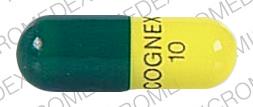Cognex Disease Interactions
There are 4 disease interactions with Cognex (tacrine).
Cholinesterase inhibitor (applies to Cognex) coronary artery disease
Major Potential Hazard, High plausibility. Applicable conditions: Ischemic Heart Disease
The use of cholinesterase inhibitors has been associated with a constriction of coronary arteries. Therapy with cholinesterase inhibitors should be administered cautiously in patients with coronary artery disease.
References (8)
- (2001) "Product Information. Cognex (tacrine)." Parke-Davis
- Benjamin KW (1979) "Toxicity of ocular medications." Int Ophthalmol Clin, 19, p. 199-255
- "Product Information. Phospholine Iodide (echothiophate iodide ophthalmic)." Wyeth-Ayerst Laboratories
- (2001) "Product Information. Mestinon (pyridostigmine)." ICN Pharmaceuticals Inc
- "Product Information. Prostigman (neostigmine)." ICN Pharmaceuticals Inc, Cost Mesa, CA.
- (2001) "Product Information. Aricept (donepezil)." Pfizer U.S. Pharmaceuticals
- "Product Information. Humorsol Ocumeter (demecarium bromide ophthalmic)." Merck & Co., Inc
- "Product Information. Eserine Sulfate Ophthalmic (PHYSostigmine ophthalmic)." Ciba Vision Ophthalmics
Cholinesterase inhibitor (applies to Cognex) parkinsonism
Major Potential Hazard, High plausibility.
Cholinesterase inhibitors should be used with caution in patients with parkinsonism. Some of these drugs might be contraindicated in these patients (refer to specific prescribing information). Symptoms of Parkinson's disease may be exacerbated with the increase in cholinergic activity. Caregivers and patients should be advised.
References (8)
- (2001) "Product Information. Cognex (tacrine)." Parke-Davis
- el-Yousef MK, Janowsky D, Davis JM, Sekerke HJ (1973) "Reversal of antiparkinsonian drug toxicity by physostigmine: a controlled study." Am J Psychiatry, 130, p. 141-5
- Benjamin KW (1979) "Toxicity of ocular medications." Int Ophthalmol Clin, 19, p. 199-255
- "Product Information. Phospholine Iodide (echothiophate iodide ophthalmic)." Wyeth-Ayerst Laboratories
- (2001) "Product Information. Aricept (donepezil)." Pfizer U.S. Pharmaceuticals
- "Product Information. Humorsol Ocumeter (demecarium bromide ophthalmic)." Merck & Co., Inc
- "Product Information. Eserine Sulfate Ophthalmic (PHYSostigmine ophthalmic)." Ciba Vision Ophthalmics
- (2001) "Product Information. Exelon (rivastigmine)." Novartis Pharmaceuticals
Tacrine (applies to Cognex) hepatic dysfunction
Major Potential Hazard, High plausibility. Applicable conditions: Liver Disease
The use of tacrine is contraindicated in patients with a history of tacrine-induced jaundice confirmed by elevated total bilirubin greater than 3.0 mg/dl. Elevations in liver function tests (LFTs) have been reported in as many as 50% of patients receiving tacrine. Twenty-five percent of patients may experience a 3 fold rise in ALT and 7% a 10 fold rise in ALT. LFTs should be monitored prior to initiation of tacrine therapy is initiated and when dosages are altered. Tacrine undergoes extensive first-pass metabolism by the liver (CYP450-1A2) to multiple forms. The metabolic and therapeutic activity of tacrine can be altered in patients with compromised hepatic function and therapy with tacrine should be administered cautiously in these patients.
References (8)
- Ford JM, Truman CA, Wilcock GK, Roberts CJ (1993) "Serum concentrations of tacrine hydrochloride predict its adverse effects in Alzheimer's disease." Clin Pharmacol Ther, 53, p. 691-5
- Summers WK, Koehler AL, Marsh GM, Tachiki K, Kling A (1989) "Long-term hepatotoxicity of tacrine." Lancet, 1, p. 729
- Ames DJ, Bhathal PS, Davies BM, Fraser JR (1988) "Hepatotoxicity of tetrahydroaminoacridine." Lancet, 1, p. 887
- Ames DJ, Bhathal PS, Davies BM, Fraser JR, Gibson PR, Roberts S (1990) "Heterogeneity of adverse hepatic reactions to tetrahydroaminoacridine." Aust N Z J Med, 20, p. 193-5
- Hammel P, Larrey D, Bernuau J, Kalafat M, Freneaux E, Babany G, Degott C, Feldmann G, Pessayre D, Benhamou JP (1990) "Acute hepatitis after tetrahydroaminoacridine administration for Alzheimer's disease." J Clin Gastroenterol, 12, p. 329-31
- (2001) "Product Information. Cognex (tacrine)." Parke-Davis
- Knapp MJ, Knopman DS, Solomon PR, et al. (1994) "A 30-week randomized controlled trial of high-dose tacrine in patients with alzheimers disease." JAMA, 271, p. 985-91
- Watkins PB, Zimmerman HJ, Knapp MJ, Gracon SI, Lewis KW (1994) "Hepatotoxic effects of tacrine administration in patients with alzheimers disease." JAMA, 271, p. 992-8
Cholinesterase inhibitor (applies to Cognex) hyperthyroidism
Moderate Potential Hazard, High plausibility.
Many of the manifestations of hyperthyroidism may be exacerbated by increased levels of acetylcholine produced by cholinesterase inhibitors. Therapy with cholinesterase inhibitors should be administered cautiously to patients with hyperthyroidism. Monitoring of thyroid levels is recommended.
References (5)
- (2001) "Product Information. Cognex (tacrine)." Parke-Davis
- Benjamin KW (1979) "Toxicity of ocular medications." Int Ophthalmol Clin, 19, p. 199-255
- (2001) "Product Information. Mestinon (pyridostigmine)." ICN Pharmaceuticals Inc
- "Product Information. Prostigman (neostigmine)." ICN Pharmaceuticals Inc, Cost Mesa, CA.
- (2001) "Product Information. Aricept (donepezil)." Pfizer U.S. Pharmaceuticals
Switch to consumer interaction data
Cognex drug interactions
There are 436 drug interactions with Cognex (tacrine).
Cognex alcohol/food interactions
There is 1 alcohol/food interaction with Cognex (tacrine).
More about Cognex (tacrine)
- Check interactions
- Compare alternatives
- Drug images
- Side effects
- Dosage information
- During pregnancy
- Drug class: cholinesterase inhibitors
Related treatment guides
Drug Interaction Classification
| Highly clinically significant. Avoid combinations; the risk of the interaction outweighs the benefit. | |
| Moderately clinically significant. Usually avoid combinations; use it only under special circumstances. | |
| Minimally clinically significant. Minimize risk; assess risk and consider an alternative drug, take steps to circumvent the interaction risk and/or institute a monitoring plan. | |
| No interaction information available. |
See also:
Further information
Always consult your healthcare provider to ensure the information displayed on this page applies to your personal circumstances.


